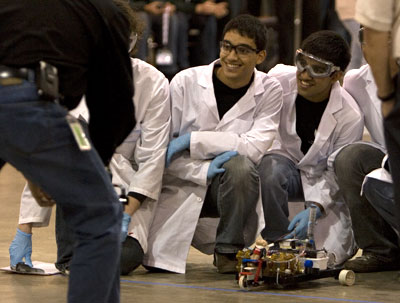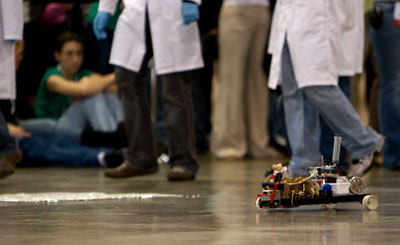With perfect accuracy, Cornell team's ChemE car wins national competition
By Anne Ju


With their shoebox-size car powered by a hydrogen fuel cell, the 18-member undergraduate ChemE Car Team placed first at the American Institute of Chemical Engineers student-car competition in Philadelphia Nov. 16, beating out more than 30 other teams. The win propels them to the international competition in Montreal next August.
The car also made history by being the first ever to stop exactly at the target distance as outlined by competition rules. The car is called Bender, after the character from the TV show "Futurama."
The competition required students to build a $2,000 car, powered by a chemical reaction of their choice, that could travel 60 feet carrying a water payload of 250 milliliters. Within two minutes, it had to go the required distance and come to a complete stop -- a rule the Cornell students call "the bane of many excellent cars ('They just kept going and going and going...')." The stopping mechanism also had to be triggered by a chemical reaction -- in other words, brakes are illegal.
The Cornell students designed their stopping mechanism around an iodine-starch mixture, which turns opaque after a certain time, depending on the amount of chemicals used. A photosensor detects the change, which trips a circuit that cuts the power from the fuel cell to the motor.
In addition to a $2,000 first-place prize and a trophy, the team also earned the "Best Consistency" prize, which took the average of two runs. After Bender's perfect first run, it again performed admirably, stopping within about 4 feet of the target.
"There's definitely an element of luck for all the teams, but the fact that we got 'Best Consistency' shows that our win wasn't a fluke," said Shihao Koh '10.
The first-place finish was especially sweet for those team members who have patiently seen Bender through some leaner times.
In an earlier model, said team captain Brian Weitzner '09, the students had burned a strip of magnesium in hydrochloric acid to stop the car, a method that proved too unreliable. Last spring they came up with the iodine-starch reaction, but again met a roadblock when they couldn't get the circuitry to work correctly.
"So now being able to have a car that not only moves, but stops, and stops where it's supposed to stop -- I'm still in shock," said Michael Klees '09.
In addition to the funding they receive from the College of Engineering and the Department of Chemical and Biomolecular Engineering, the students plan to put their prize money toward building a second car, this one battery powered. Bender will also see improvements, including a new fuel cell -- this one designed, rather than store bought.
Get Cornell news delivered right to your inbox.
Subscribe